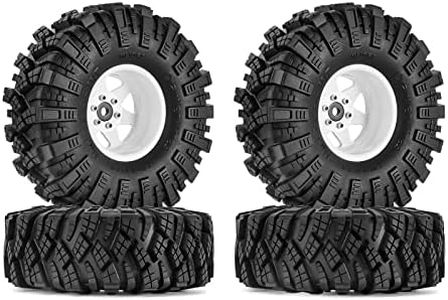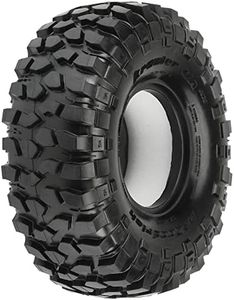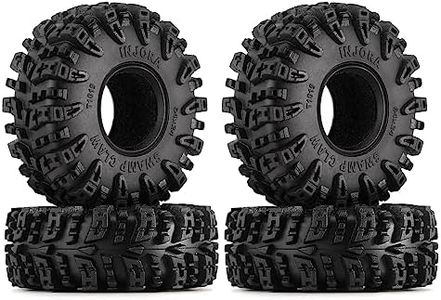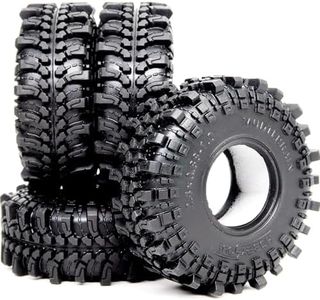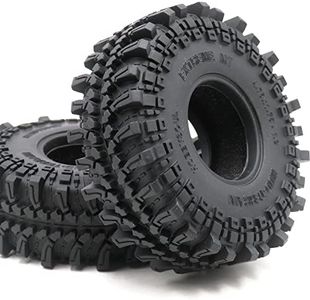We Use CookiesWe use cookies to enhance the security, performance,
functionality and for analytical and promotional activities. By continuing to browse this site you
are agreeing to our privacy policy
10 Best Mud Terrain Tires
From leading brands and best sellers available on the web.Buying Guide for the Best Mud Terrain Tires
Choosing the right mud-terrain tires is all about understanding where, how, and how often you'll be driving off-road. These tires are designed for people who need more traction in muddy, rocky, or loose surfaces rather than just highways or city roads. The right tire will keep you safe and comfortable in tough conditions, but also handle everyday driving if needed. Before picking a tire, think about your off-roading frequency, the typical terrain you'll encounter, and whether you'll be driving in wet, dry, or mixed weather. Getting the right combination of features will make a big difference in performance and satisfaction.Tread PatternThe tread pattern is the design and arrangement of grooves and blocks on the tire's surface. For mud-terrain tires, aggressive and deep tread patterns are crucial as they provide extra grip in slippery, muddy, or loose environments. Patterns with widely spaced lugs help to eject mud and dirt, preventing the tire from clogging up and losing traction. For heavy off-road use, prioritize tires with the boldest and most open patterns. If you spend time both on- and off-road, you might want a slightly less aggressive pattern for a quieter ride on pavement.
Sidewall StrengthSidewall strength refers to how tough and resistant the sides of the tire are to punctures, cuts, and abrasion. Mud-terrain tires often have reinforced or multi-ply sidewalls to handle rocks, roots, and rough trails. Stronger sidewalls mean better durability and less chance of damage when tackling off-road obstacles, but they can also feel firmer during regular driving. If you travel over rocky or unpredictable ground, prioritize high sidewall strength. If you mostly encounter mud with less risk of sharp things, moderate strength may be enough.
Tire SizeTire size includes the width, diameter, and aspect ratio of the tire, all of which affect performance and compatibility with your vehicle. Larger and wider tires offer more surface contact and can help your vehicle float better over soft mud, but they may require modifications like lifts or different wheels. Smaller tires fit more vehicles but may struggle in deep mud. Always check what sizes your vehicle can accommodate without rubbing or clearance issues, and balance size with your off-roading needs and vehicle limitations.
Load RatingThe load rating indicates how much weight a tire can safely support. In mud-terrain tires, this is especially important if your vehicle carries heavy gear, passengers, or tows trailers. Higher load ratings mean the tire can handle more weight but might have a stiffer ride. Choose a rating that matches or exceeds the recommendations for your vehicle and usual activities to ensure safety and performance both on and off the road.
Traction RatingTraction rating shows how well the tire grips various surfaces, with many mud-terrain tires optimized for soft, disagreeable ground rather than paved roads. Look for traction ratings that reflect your most common terrain; some tires excel in deep, sticky mud, while others are better on slippery rocks or wet grass. If you frequently face demanding, slippery trails, go for tires with the highest off-road traction ratings. If your off-roading is more occasional, a balanced traction profile will help with versatility.
Road Noise and ComfortRoad noise and comfort describe how loud and smooth the tires are when driving on regular roads. Mud-terrain tires often make more noise and ride more harshly because of their aggressive patterns and tough build. If most of your driving is off-road, this may not matter, but if you spend a lot of time on highways, you might want to look for tires that try to minimize noise and improve comfort—many newer designs offer a compromise between off-road grip and on-road peace.

